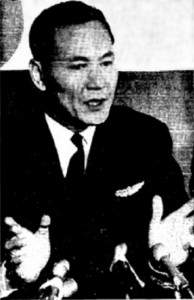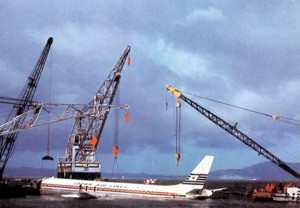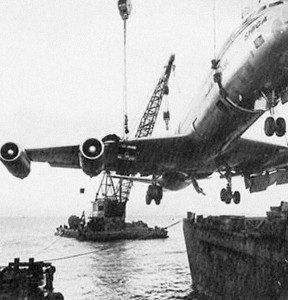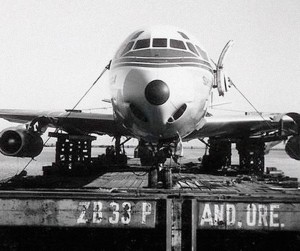Published on November 22, 2012
By Thomas Van Hare
Descending through fog on approach into San Francisco, JAL Flight #2 passed through 600 feet on the pressure altimeter. On his Radar Altimeter, Captain Asoh noted that his static pressure altimeter reported 500 feet. Seeing a deviation, he asked his copilot, Joseph Hazen, for regular 100 foot altitude calls as they continued down toward the runway on a standard ILS approach. For some reason, just moments later, the copilot did not call the 400 foot mark. Captain Asoh asked again. Momentarily confused, the copilot reported instead an altimeter setting of 30.31″. Seconds later, the Minimum Descent Altitude indicator light (MDI) flashed on — Captain Asoh had set it at 211 feet. A quick glance showed the altimeter at 300 feet and the copilot called, “Breaking out of the overcast. I cannot see the runway light….”
The runway lights of San Francisco should have been directly ahead. Instead, all they saw was water. Instantly, the two pilots realized that they were well below 200 feet. The copilot yelled, “We are too low — pull up, pull up!” He didn’t need to say it as Captain Asoh had already pushed the throttles forward. Pulling back on the control column, he pitched the nose upward and hoped they could start to climb again. He knew, however, that it was too late. There was a sudden drag as the main landing gear struck the water. A huge splash exploded skyward as the airplane twisted 65 degrees to the left. Captain Asoh chopped the power to try and avoid flipping over forward — but then the nose wheel hit and dug in….

Anatomy of an Accident
The flight of Japan Air Lines Flight #2 (JAL 2), a DC-8-62, JA8032, nicknamed “Shiga”, from Tokyo to San Francisco had been a normal transpacific crossing. It had departed Tokyo International Airport at 0836Z (1736 Tokyo Time). As the plane climbed out, Capt. Kohei Asoh noticed deviations between his pressure altimeter and the copilot’s. At each level off, his altimeter would continue to show an upward climb, while the copilot’s altimeter leveled off. The deviation was as much as 120 feet, leading him to believe that he could not trust the altimeter. The rest of the flight proceeded uneventfully and the plane arrived in the San Francisco area at 1654Z (0854 Pacific Time).
After descending to 8,000 feet of altitude, the aircraft was vectored to the Woodside VOR after a request by Capt. Asoh for a long straight in approach. From there, the flight given a heading to pick up the ILS approach onto San Francisco’s Runway 28. At 4,000 feet of altitude, the plane was given a clearance to 2,000 feet and the pilots commenced a steady descent toward San Francisco. Captain Kohei Asoh was advised of fog with a reported ceiling of 300 feet. Visibility was 3/4 of a mile.
Landings in fog were fairly routine and should have been no problem on an ILS approach, which gave him 200 foot minimums. Capt. Asoh decided to undertake an autopilot coupled approach. Typically, such an approach involved leveling off after having flown to a position adjacent to the localizer beam, below the glide slope while outside the Outer Marker. At that point, the crew would set the flight director and autopilot to fly the plane to the localizer beam (an indicator that tells the pilots if they are left, right, or on the direct line to fly to the runway). When the plane reaches the point where the glide slope intersects, the autopilot will pitch the plane over to fly the approach to landing. Since Capt. Asoh had seen altimeter deviations of nearly 120 feet on his side of the panel when compared with the copilot’s gauges, as a cross check, he decided to cross check against the Radio Altimeter for altitude information.
All of these steps should have been more than reasonable to ensure a safe landing, yet they still didn’t prevent an accident that day. So just why did Captain Kohei Asoh fly a “perfectly good airplane” into the water that day? It happened today in aviation history, on November 22, 1968.
Unaware that he was about to make history — and not in a good way — Capt. Asoh continued what he thought was a normal ILS autopilot coupled approach. He set his Minimum Descent Altitude indicator to light at 211 feet Above Sea Level (the “Missed Approach Point”, which was where, if the runway wasn’t in sight, the pilots were to abort the landing and initiate a go-around). When the radio altimeter read 500 feet, Capt. Asoh cross-checked the altitude against the reading on his pressure altimeter, which he had found earlier in the flight to have been inaccurate. At that moment, he noticed a deviation once again. While the radio altimeter read 500 feet, the pressure altimeter read 600 feet of altitude.
To be prudent, Capt. Asoh asked his copilot, First Officer Hazen, to give him an altimeter reading as a second cross-check. However, the First Officer responded by giving him the pressure altitude setting that was dialed into the altimeter instead — saying, “30.31.” Nonetheless, the copilot, First Officer Hazen, in accordance with the landing brief, started calling altitudes every 100 feet starting at 500 feet on down. Perhaps preoccupied, Capt. Asoh stated later that he didn’t hear any of these calls over the intercom.
Captain Asoh had nearly 9,800 hours of flight time. In fact, he was one of the senior pilots at Japan Air Lines. He had worked with the airline for 15 years — and previously, he had been a military flight instructor during World War II, training Japanese pilots. For this route — Tokyo to San Francisco — he flew JAL’s newest aircraft, the four-engine Douglas DC-8. In this new type, he had already logged more than 1,000 hours of total time. His copilot, Joseph Hazen, was an American and highly experienced too with over 9,600 hours of flight time as of the date of the accident — however, he wasn’t a JAL direct hire, but rather an IASCO contract hire. He was eminently qualified and a former Air America aviator. Prior to that, he had been US Marine Corps pilot.
The flight engineer, Richard Fahning, was experienced as well with just over 4,700 of flight time. The navigator, Ichiryo Suzuki, was the least experienced of the flight crew, having just 657 hours of flight time. In fact, he had only been flying with Japan Air Lines since earning his Navigator’s Certificate 11 months before. As it happened, the navigator played no role in the events of the day. The crew was well-rested and not impaired whatsoever. Everything seemed fine. In the back, there were 96 passengers plus an additional 7 flight attendants — 11 of the passengers were infants.
As the flight proceeded toward landing — though it wouldn’t be a landing on the runway — Capt. Asoh saw the MDA light illuminate. He cross-checked his instruments and noted that his pressure altimeter read 300 feet, which he viewed as a further confirmation that it was inaccurate. He looked up from the instruments, as is normal to see if the runway lights were in view. If not, the procedures called for the pilots to commence a “Missed Approach”, which involved adding power, pitching the nose upward, and making a turn as the plane climbed out. The procedure then called for the pilots to either circle back and attempt another landing or to proceed to their filed alternate destination — if the weather was better there — and landing there instead.
When the pilots realized they could not see the runway lights, they tried to add power and pitch up. The pull up was delayed apparently, and the Flight Engineer called out, “Pull up, pull up!” It was too late, however.

The Crash and Aftermath
Incredibly, when the DC-8 hit the water, it did not flip over. An eye-witness later reported, “I heard the plane very low, coming in. I looked up and there it was, splashing down, just beautifully.” In fact, the water landing was nearly perfect. Somehow, despite the impact, there was no violent stop or rending of the wings and fuselage. Instead, the plane splashed down and came to a full stop. Then, slowly, it sank into the water half way down. By equally lucky chance, JAL Flight #2 had even landed in a shallow area of the San Francisco Bay. Where it settled to the bottom, the waters were just 10 to 12 feet deep. This allowed the wheels to touch the bottom of the Bay and left the top half of the airplane high and dry.
In the cockpit, the copilot switched off a few items, though he later didn’t remember which, while the Flight Engineer shut off fuel flows and closed valves to prevent a fuel leak. Everything was done perfectly, as if practiced the day before. The captain felt the wheels touch bottom and recognized that the plane was stable on the seabed. He reached up an selected the cabin intercom to advise the cabin of what had happened. Many of the passengers, those without window seats, didn’t even know that the plane was in the water. Most of the carry-on baggage under the seats was still in place, though some bags had slipped forward as much as two rows of seats. The most scary thing at the time of impact was that some overhead bin covers had torn free and flown through the passenger compartment. Even there, nobody was hit.

For five minutes the cabin crew discussed what to do. Meanwhile, the passengers waited patiently, still sitting at their seats. The passengers could hear the gentle lapping of the waves against the sides of the plane. Not even their feet were wet as everyone was sitting above the water line. Then Captain Asoh spotted what he thought was jet fuel leaking from the wing tanks. Fearing a fire, he issued the order to evacuate the plane onto rafts. With orderly precision and little panic, the passengers stood up, donned life jackets, and walked to the cabin doors.
The flight attendants opened the doors and inflated the rafts. One by one, they assisted passengers out. Once each raft was full, they pushed it off from the plane and the passengers rowed toward shore. Incredibly, nobody was injured, not even slightly. With everyone aboard the rafts, the purser made a final cabin check. Finding nobody left behind, he boarded the last raft and they too pushed off toward shore.
On the raft that held the copilot, First Officer Hazen, and some of the passengers, as they rowed toward shore, a tiny flat-bottomed fishing boat motored up. The fisherman, who coincidentally turned out to be a pilot with Western Airlines, asked if he could assist by towing the rafts. Seeing everyone in good condition, he tossed a bottle of J.W. Dant Kentucky Straight Bourbon Whiskey to the passengers and the copilot, who gladly accepted. The copilot, on recounting the matter later to the authors at Historic Wings, recalled that he was tempted to take a drink. He refrained because he realized that he might later be alcohol tested and accused of “drinking on the job”. As it turned out, his fishing boat’s engine wasn’t powerful enough to tow even a single raft.
Therefore, the passengers and crew started the long row to shore. The First Officer, Joseph Hazen, related that after a time the US Coast Guard arrived with a whale boat and towed them in the rest of the way. Finally, they stepped onto the beach and as incredible as it might seem, most didn’t even get their ankles wet. It was a weird scene, to say the least, as the passengers looked back at the plane sitting above water as if parked in the Bay a few hundred yards off shore. There would be no baggage claim (their bags, in the bottom of the fuselage, were wet anyway) and no taxi ride downtown. However, at least they were safe.

The Investigation
Just 55 hours later, the plane was lifted onto a barge with the help of several maritime cranes mounted on barges. It was taken ashore for a full evaluation. The undamaged flight recorders revealed that everything had worked well, except the reported altimeter issues — yet those were not to blame for what happened.
A couple of days later, the NTSB interviewed the First Officer, Joseph Hazen, and the Flight Engineer, Richard Fahning. The two quickly learned that Capt. Asoh was not present, apparently being in the care of a doctor. When first Hazen was called in for the interview, he replied that he had nothing to say because Capt. Asoh wasn’t there. The interview ended as quickly as it had begun and Hazen walked out the room, told Fahning what he had said, and waited. Less than five minutes later, Richard Fahning exited too. Neither would say anything without Capt. Asoh in the room. The NTSB, none too happy, was forced to wait. Investigators being as they are, any hope they might have had to find gaps between the stories of the flight crew members’ accounts were dashed — not that it would have added anything valid to the investigation.
From the flight data recorders, the accident investigators uncovered part of the explanation. Put simply, by selecting an autopilot coupled ILS approach, Captain Asoh and his copilot, Joseph Hazen, effectively ignored their actual position and trusted the system to do the ILS approach down to minimums — 211 feet. According to the NTSB, because they didn’t fully understand the workings of the Sperry Flight Director system and autopilot system, they had ridden the plane down to the water, essentially without any reference to the glide slope indicator in the ILS window at all.
In other words, for the entire approach, they had been below the glide slope, on a perfect descent path to land two and a half miles short of the runway. Both pilots trusted the autopilot to recognize and fly the glide slope itself — however, it wasn’t designed that way. The autopilot had kept the plane right on the localizer, however, so they landed in perfect alignment with the runway — though well short. It just happened to be that their approach path was over the Bay. Left unsaid in the final NTSB report was that the air traffic controllers at San Francisco, who had altitude read-outs from the plane’s transponder signals, did not issue any warnings, nor did they recognize the problem. It was a comedy of small errors that added up to a big mistake.
A key finding in the NTSB report did state that the overall cause was put down to a generalized lack of training on the Sperry Flight Director System by Japan Air Lines — other pilots in the airline also reportedly felt uneasy and uncertain of all aspects of its use and performance. Beyond this, the NTSB also noted that there was a visually confusing indication in the cockpit, where the horizontal bar on the HZ-6B (an instrument in the cockpit called a horizontal flight director indicator, ADI) would visually appear similar to the glide slope indicator when the rate of descent was selected “one unit down”, as was apparently the case given the flight data recorder data. Thus, the pilots may have been misled by the HZ-6B indicator, thinking it to be a glide slope indicator that was, therefore, centered where it should have been. In the words of the NTSB report, “It would have the same appearance as a glide slope being flown on the centerline with the exception of the annunciator lights for both the flight director and the autopilot being in the ‘Glide Slope Arm’ position.”
There was one other glaring error in crew coordination — and the NTSB chalked this up to language difficulties between the Captain and the First Officer. This was that normally, at the Decision Height, which is the Minimum Descent Altitude at which the pilot is to commence a Missed Approach by adding power, pitching up and going around, the First Officer would call out whether the runway was in sight or not — and if not, the Captain would undertake an immediate Missed Approach procedure, without looking up to see if he could see the runway lights himself. As it happened, Capt. Asoh looked up and tried to determine for himself where the runway was. By the time he even added power, therefore, the plane was already passing through 150 feet of altitude.
Capt. Asoh’s delay in executing the Missed Approach, even if it was just a few seconds long, is what really caused the plane to impact the water. When he had heard the First Officer Hazan call out that he could not see the runway was in sight, he should have simply added power and gone around. Had he done so, there would never have been an accident.

The Asoh Defense
Months later, Captain Asoh was called to testify at the National Transportation Safety Board hearing. There were many things he could have said. He could have cited the distraction caused by the disagreement between altimeter readings. He could have blamed his copilot for not calling the altitudes properly as requested. He could have pointed out that ATC hadn’t reported he was low. He could have claimed that the coupled approach was misleading since it wasn’t clear that the autopilot didn’t fly the altitude as well as the heading. He could have said many things. Instead, he did not.
Captain Asoh recognized that it all came down to him. As the true and honorable man and as captain of the aircraft, he accepted full and complete responsibility. That the autopilot would not fly the glide slope automatically was something that he should have known. Somehow, he had ignored the glide slope indication in the ILS window, which showed him to be well below the approach path the entire time. Whether the other crew members did or did not was of no concern to him — he had made the mistake and he had the honesty to accept that.

Therefore, Captain Asoh looked directly at the NTSB board and uttered what has since become known in legal circles as the Asoh Defense — “As you Americans say, I fucked up.” With that, the case was essentially closed. Cursory interviews with the rest of the crew followed. The final recommendations required additional training for Japan Air Lines pilots on coupled approach procedures. The plane was hosed down and what little damage done was fully repaired — it returned to service with JAL and flew for years afterward.
In the wake of the accident, Japan Air Lines set up an improved training program on the Sperry Flight Director system and autopilot. As Joseph Hazan later recalled, “I think it turned out nobody really knew the system from reading the handbook, but did not want to admit it. This is my opinion.” Other sources conclude the same — one interesting note was that the JAL manuals on operating the DC-8 were based on Boeing manuals, which were in English that had been translated to Japanese. Rather than referencing the original Boeing manuals, the JAL manuals had instead just been translated again from Japanese back to English. This was what was the American flight crew members had trained with and used, not just on that aircraft, but for all JAL English-speaking crew members. It was a long error chain indeed.
As for Captain Asoh, he was demoted by JAL to the role of copilot and reassigned to fly cargo operations for the rest of his career. Above all, he preserved his honor and integrity to the end.
Another Bit of Aviation History
Did you know that a Douglas DC-8 airliner once flew faster than the speed of sound? On August 23, 1961, in a USAF test that involved the Douglas Aircraft Company, a DC-8 was flown faster than the speed of sound. Accompanied by two chase planes — an F-100 photo aircraft and an F-104 pacer plane, the DC was taken to an indicated altitude of 50,029 feet. At near maximum power (97% N2), the nose was pitched downward steeply. As the plane descended past 40,350 feet of altitude in the hands of test pilots William M. Magruder and Paul H. Patten, it achieved Mach 1.012, logging a true airspeed of 660.6 mph.
The recovery was supposed to have begun at 42,000 feet, however, the application of up elevator revealed that a Mach shock wave was blocking control authority. This was a bit unexpected and very dangerous. As the plane passed through 39,000 feet, the pilots attempted to pull-out by using just the elevator trim tabs, a technique developed during WWII when fighter pilots faced “compressibility”. At 35,000 feet, the nose raised somewhat and the pilots could feel a buffeting as the plane decelerated. A severe rudder pedal buzzing was felt through their feet — possibly this indicated harmonic flutter, which could well have destroyed the plane. Finally, before reaching 30,000 feet, the plane recovered from its dive. The pilots returned for a normal landing. After the flight, no damage was found despite an extensive inspection.
Today’s Aviation Trivia Question
Has any other airliner ever exceeded Mach 1.0 (other than the SSTs, such as the Concorde, etc.)?

I remember reading a long time ago of a United Airlines Boeing 720 going through several wind shear incidents and actually going supersonic as it descended. If I recall correctly the controls froze but the crew waited for the aircraft to enter into denser atmosphere where the aircraft slowed and the crew was able to raise its nose and continue to fly. There was also story of a Pan American Boeing 707-121 (N711PA?) coming out of maintenance and diving from 30,000 feet over the Atlantic to try to break the sound barrier. It didn’t do it. Supposedly the crew broke out of the dive at 6,000 feet. Perhaps that explains why ‘711’ had a little more sweep to its swept wing.
The story of Captain Ahso is featured in the book, “The Abilene Paradox” in the Chapter “Captain Ahso and the Concept of Grace.” The story is written for the less aviation savvy, and included to show the benefits of being honest — especially when you screw up. The entire book is well worth the read for leaders and managers.
I am confused by one part in the story. Is it that the autopilot did not couple with the glideslope (I have seen that happen, especially when trying to intercept from above — generally they will not) or that it could not couple (wasn’t designed to — like the STEC-50 in my O-2A), or that there was a systems failure (and I have seen that, too). The text isn’t clear.
I was the FO on this flight and this report has several errors.
FYI, several months later I checked out as a DC-8 captain and
in 1973 was checked out as a B-747 captain and flew for JAL in
this position until I retired in 1994.
Hello Joseph,
My father was the flight engineer that day (Richard Fahning). I would very much like to get in touch with you (Joseph) and talk about the good old days. You can reach me threw my email and I will provide my phone number then. I have a lot of history to share, as I followed in my dad’s footsteps. I have almost 20,000 hours flying, including time in the DC-8. I hope to hear from you soon.
Regards,
Frank